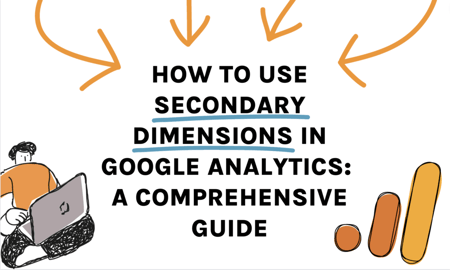Optimize Your Reporting Accuracy With Additional Dimensions
In the world of information analysis, the quest for precision and deepness is a continuous search. Secondary dimensions supply a gateway to boosting reporting precision by supplying a multifaceted lens where to see information. Imagine the power of unraveling elaborate layers of information that lie beyond the surface area metrics, providing a richer tapestry of insights waiting to be checked out. As we start this trip of leveraging additional dimensions, the landscape of reporting accuracy bids with promises of boosted clearness and strategic decision-making.
Significance of Secondary Measurements
Using additional measurements is vital for improving the depth and granularity of reporting understandings in data analysis. By integrating additional dimensions into information analysis processes, businesses can gain a more detailed understanding of their efficiency metrics. These additional dimensions provide an even more detailed sight of the main data, permitting a more nuanced analysis of fads and patterns. Second dimensions enable analysts to sector and filter data based on particular standards, providing a much more customized and targeted analysis.
Moreover, second dimensions assist in determining relationships and partnerships that might not be promptly evident when assessing data with only main measurements. This deeper degree of understanding can result in even more enlightened decision-making and strategic planning within a company. By leveraging second dimensions successfully, organizations can uncover hidden possibilities, pinpoint areas for renovation, and maximize their overall performance.
Applying Additional Dimensions
To incorporate second dimensions efficiently right into information evaluation processes, services need to take on a structured approach that straightens with their coverage purposes and analytical goals. Applying secondary dimensions includes selecting the ideal measurements that give much deeper insights right into primary information metrics. It is essential to determine which secondary measurements will boost the understanding of the main information being assessed. Businesses must think about factors such as the sort of information being collected, the details metrics they intend to analyze, and the vital efficiency indicators (KPIs) they are concentrated on improving.
Furthermore, businesses require to make certain that the picked second measurements relate to the key data and give purposeful context without creating details overload. Carrying out secondary measurements likewise requires specifying clear logical questions that the added measurements will certainly help respond to. By structuring the implementation process around these considerations, companies can make best use of the value originated from additional measurements and enhance the accuracy and deepness of their reporting.
Studying Information With Second Dimensions

One secret aspect of assessing data with secondary dimensions is to ensure that the picked measurements line up with your certain logical goals. Picking the right second dimensions best site can give context and nuance to your primary data metrics, allowing you to draw more precise conclusions and make educated decisions based upon the understandings obtained.
Additionally, leveraging second measurements efficiently can aid in recognizing outliers, recognizing the effect of different variables on your vital efficiency indicators, and gaining a detailed view of your data landscape. By delving into data with additional measurements, you can boost the depth and top quality of your analysis, resulting in even more robust reporting and workable results.

Enhancing Insights Through Second Dimensions
Checking out data with second measurements not only deepens evaluation however additionally magnifies the possibility for revealing beneficial insights that can significantly boost reporting accuracy. By including additional measurements to your reports, you can gain a more extensive understanding of the partnerships between different information factors. This improved viewpoint enables you to determine patterns, trends, and correlations that may have been overlooked when evaluating information with key measurements alone.

Basically, leveraging additional measurements empowers you to remove richer understandings from your data, enabling you to make more enlightened decisions and enhance your reporting precision.
Best Practices for Second Dimensions
Making use of second measurements effectively calls for cautious consideration of crucial strategies to boost information analysis and reporting precision. When implementing second dimensions, it is necessary to straighten them with your key metrics to acquire purposeful understandings. One ideal practice is to utilize second dimensions moderately, focusing on those that directly contribute to the specific evaluation goals. By avoiding the lure Resources to include excessive dimensions, you can preserve clarity in your reporting and stop information overload.
One more important practice is to explore various mixes of secondary and key dimensions to uncover one-of-a-kind correlations and patterns within your data. This repetitive method can expose important understandings that might have been ignored or else. In addition, it is very important to routinely assess and fine-tune your second measurement choices to ensure they remain appropriate and lined up with your advancing reporting needs.
Additionally, documenting the rationale behind your choice of second measurements can offer context for future evaluation and assist in collaboration within your team. By complying with these best methods, you can maximize the performance of second dimensions in enhancing your reporting accuracy and driving notified decision-making.
Conclusion
Integrating second dimensions in information evaluation is critical for making the most of reporting accuracy and acquiring much deeper insights right into efficiency patterns. Applying best practices for second measurements enhances the deepness of analysis and boosts the relevance of reporting end results.
Moreover, secondary dimensions aid in identifying correlations and relationships that might not be immediately noticeable when assessing data with just main dimensions. Applying second measurements includes picking the right measurements that offer deeper understandings into key information metrics. Applying additional measurements also calls for specifying clear analytical concerns that the additional dimensions will aid answer.When assessing data with second dimensions, it is crucial to focus on drawing out valuable insights that complement primary information metrics. By including second dimensions right into your evaluation, you can discover patterns, patterns, and partnerships that might not be apparent when looking at the data from a key measurement alone.